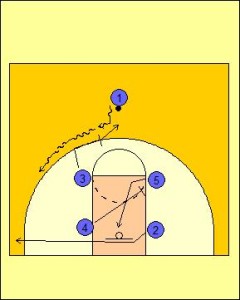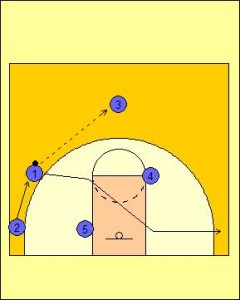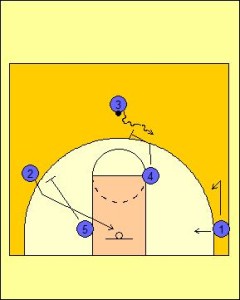Box Offense: High On-Ball Play
One of the great features of a Box Offense is it condenses the defence into a very small area. This spacing allows the offense to gain a large amount of clean space on the floor to move within. The Box Offense High On-Ball Play looks to rapidly bring defenders away from the keyway with each side of the court the play is continued on.

This Box Offense Play starts in the standard formation. Initially the ball handler wants to go away from the side that the Shooting Guard (Two) is positioned on. This is due to Two (2) using the opposite low post player in the box formation as a screen to help gain separation between themselves and their defender.
The play starts with the ball handler pausing to allow time for Two (2) to move to what will become the strong side long corner.
Three (3) lifts from the strong side High Post to set a high on-ball screen.
As One (1) starts to make a move, Four (4) lifts to set a screen for Five (5) at the opposite side High Post. If the screen set by Four (4) happens early enough the Five’s (5) defender will still be hugging the player trying to deny the post entry pass from One (1).
Five (5) needs to be conscious of how their defender is playing and utilise the screen to gain the most amount of advantage.
One (1) should be looking to use the on-ball screen as an attacking opportunity. This tactic is not just to get the player free, but create a scoring opportunity.
The timing of the Box Offense High On-Ball Play should be:
- Two (2) reaching the three-point line as;
- One (1) passes the shoulder of Three (3);
- Five (5) cuts to the basket

If One (1) cannot make a scoring opportunity out of the on-ball, the ball handler continues to progress the ball to the strong side foul line extended.
Just because the on-ball screen did not result in a scoring opportunity does not mean that a pass cannot be made to the exchange that happens between the two interior players (Four and Five).
The ball once advanced to the wing position can be reversed back to the Point Position.
Once the pass is made One (1) cuts first to the vacant High Post and then through the keyway into the weak side long corner.
Cutting to the High Post position helps One (1) head into space on the floor.
As One (1) vacates the wing position, then Two (2) lifts to the now vacant position left by One (1).

Three (3) waits for One (1) to progress to the soon to be strong side long corner.
Four (4) then lifts to set a high on-ball screen for Three (3).
Five (5) lifts to set an up screen for Two (2).
Two (2) cuts over the screen, ensuring the cut is ball side to the basket.
Three (3) dribbles over the screen and looks to attack the keyway aggressively.
If One’s (1) defender looks to help stop the dribble penetration by crowding the driving lane. Then One (1) should look to back door cut.
One (1) can also look to shake free of their defender by lifting up the passing lane and if the defender reaches too high to deny the possible passing option; then One (1) will dive to the basket.
The Screening action between Five (5) and Two (2) should pull the help defenders away from the split line.
The timing of the Box Offense High On-Ball Play should see Three (3) attacking to keyway as Two (2) is reaching a receiver spot.
The Box Offense High On-Ball Play looks to use two side of the floor to create space and increase the opportunities to attack the keyway.








Leave a Reply